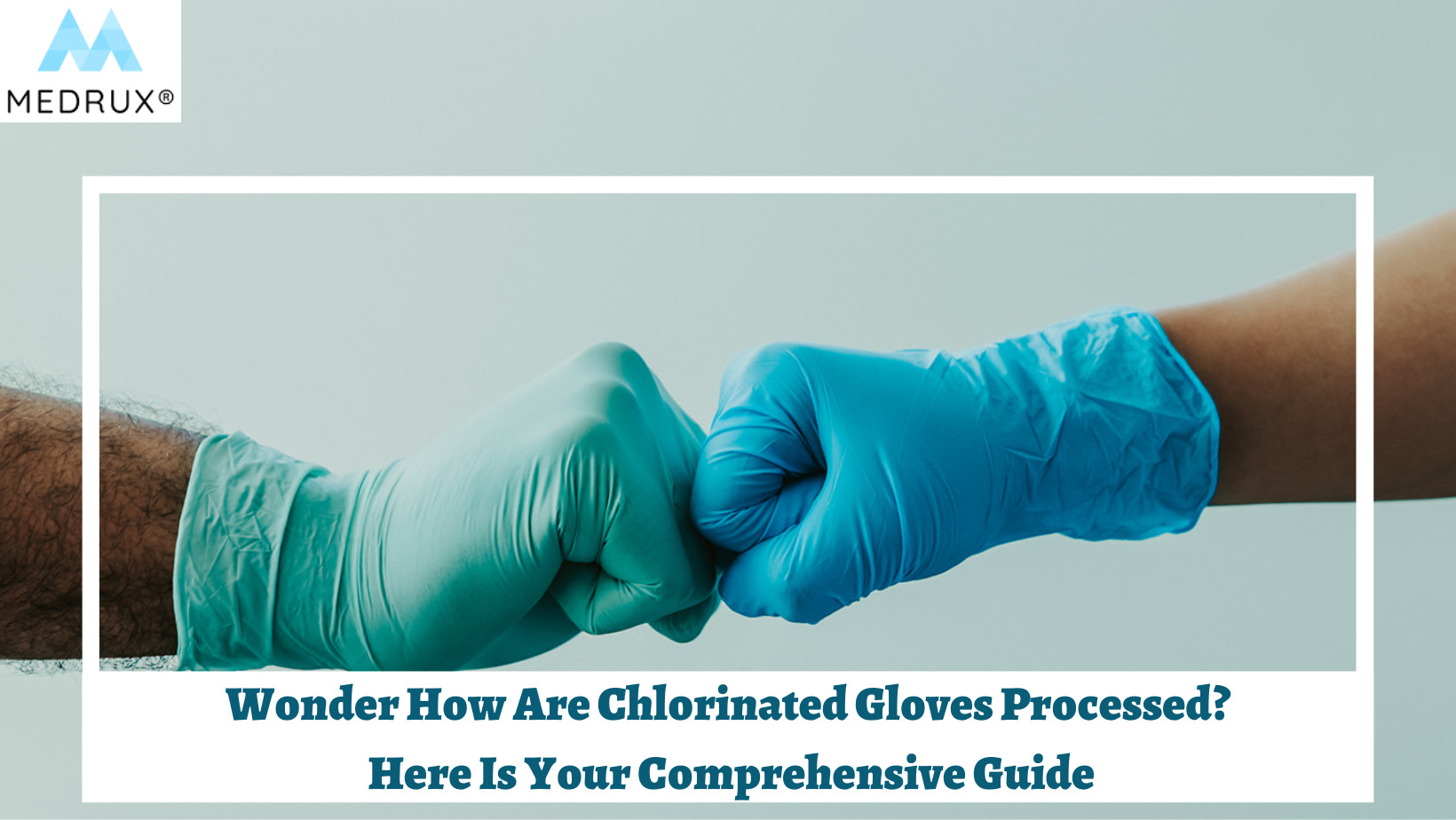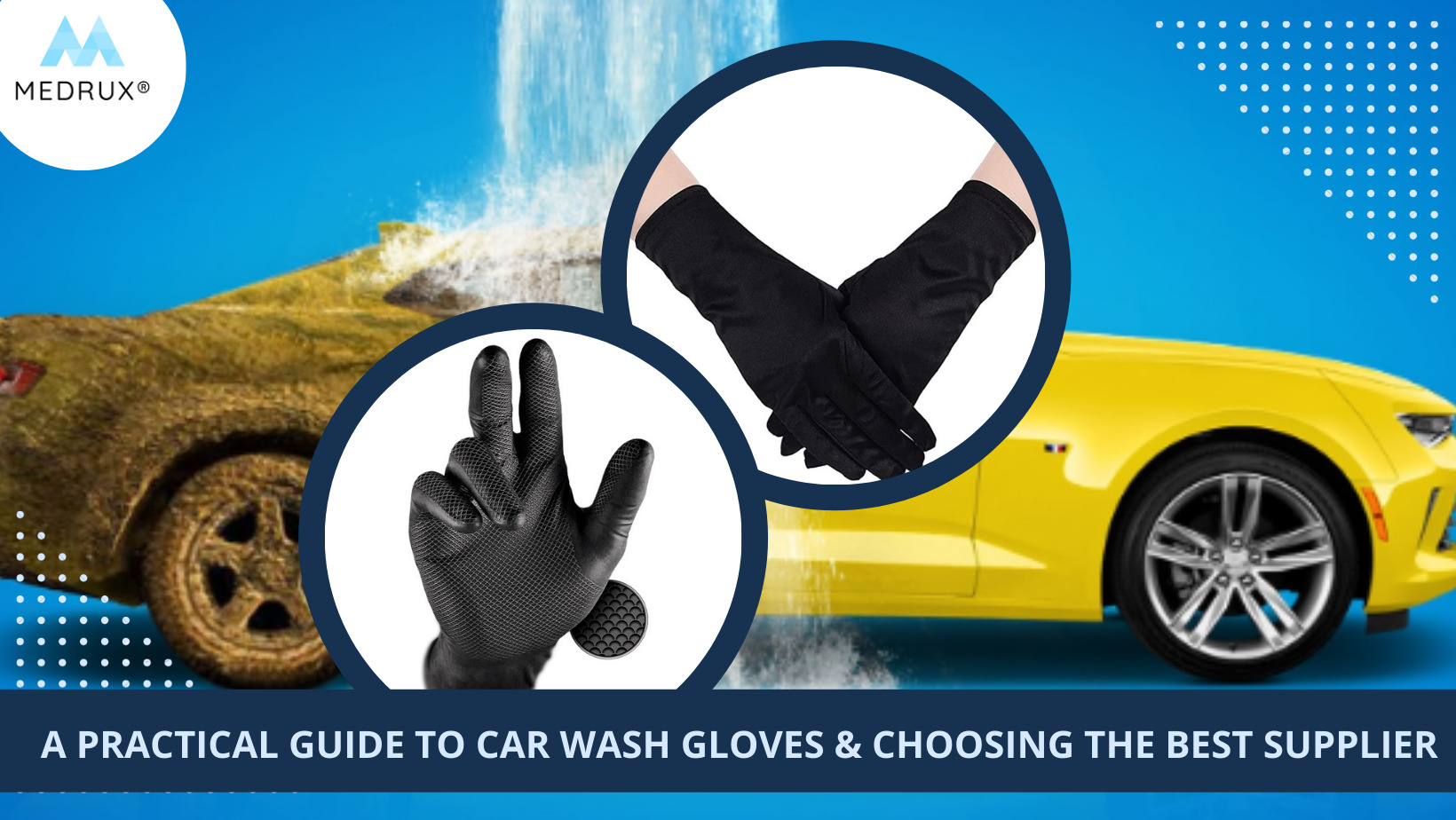Nitrile gloves have become the most popular type of disposable gloves.
The global nitrile gloves market was estimated at USD 8.76 billion in 2021 and is expected to expand at a compound annual growth rate (CAGR) of 5.7% from 2022 to 2030. [1]
As far as I know, nitrile gloves have many of the same advantages as natural latex gloves, such as flexibility, dexterity, and a snug fit.
However, they reduce the risk of allergic reactions because nitrile is a synthetic rubber that appears to lack the properties that cause allergies in latex.
There are different types of disposable nitrile gloves such as industrial or medical types.
Then, how to properly choose the right glove for your task?
Well, there are many factors that you have to consider before buying a glove.
For instance, article 1910.138(b) states that:
“Employers shall base the selection of the appropriate hand protection on an evaluation of the performance characteristics of the hand protection relative to the task(s) to be performed, conditions present, duration of use, and the hazards and potential hazards identified.“
For this reason, everyone mainly keeps in mind the type of job, the glove size, color, thickness, and whether it is powdered.
In this article, we will focus on the glove thickness factor.
In particular, the reason why there are different glove thicknesses on the market.
Besides, the different applications for each type.
Moreover, the glove color in related to its thickness.
And there is a lot more to discover through lines.
So, all you have to do now is relax and read slowly.
Hopefully, you will find it enjoyable.
Why does Glove Thickness Matter?
First, the thickness of any glove remarkably affects the types of jobs it can handle.
It is essential with nitrile gloves, which are known for their durability but can also be inflexible.
Then, you’ll want to find the right balance between dexterity and protection.
A thin glove is cheaper to produce since it requires less material.
It also improves tactile sensitivity, essential for tasks requiring extreme precision. But, a thick glove consumes more material, making it much more robust.
In the case of nitrile, a glove is even more puncture and chemical-resistant.
The basics of Glove thickness
There are numerous methods for measuring thickness. [2]
Some places use Micro Meters or Microns, a unit of length equal to one-millionth of a meter.
But, in America, the most popular way is by using mils.
Then, what is Mil?
Contrary to frequent belief, a mil has nothing to do with millimeters; it is a thickness unit equal to one-thousandth (.001) of an inch.
In other words, 1 mil = 0.001” gauge.
To clarify this point, a glove of 2 mils and below is considered thin, while gloves above 2 mils are generally considered thicker.
When measuring the thickness of a glove, keep in mind that the results can vary greatly depending on which part of the glove is measured. [3]
Since gloves are made by dipping hand-shaped formers in liquid material with fingers pointing down.
As they dry, the law of gravity applies to pull the solution downward.
For this reason, fingertips are always the thickest part of the glove.
For example, a thickness measurement taken from the fingertips will always be much thicker than a measurement taken on the palm of the glove.
Because of this, it is better to measure the palm of the glove.
However, not every factory or seller does this.
This will lead us to reconsider if it was the only way to choose the wanted thickness by relying only on the specification sheets of each manufacturer.
How to Choose Nitrile Glove Thickness?
When it comes to glove thickness, it’s not as simple as picking the highest number.
Because the thickest nitrile gloves are not always the best choice for every application.
As for me, I think that you should get your hands physically on the gloves and feel the difference of each thickness by yourself.
Unfortunately, it is very challenging to identify which gloves are poorly produced without simple trial-and-error.
However, in general speaking, and as we mentioned before, different industries depend on different glove thicknesses.
So, here are more details for each glove mil with examples of its applications: [4]
-
Goves with a thickness of 3 mils or less
They are appropriate for jobs that do not require extensive chemical or hazardous material protection.
They are preferred for applications requiring frequent glove changes, such as food service, janitorial, and beauty salons.
Besides, healthcare workers usually wear 3 to 5 mils gloves.
Dentists and doctors must use a glove that is thick enough to withstand punctures but still thin enough to retain tactile sensitivity.
-
Gloves in the 5-mil to the 6-mil
Good for a wide range of applications.
They are for situations where you need more protection against tears or will be handling chemicals for longer periods.
-
Gloves with a mil thickness of 8 and above
These gloves are rated for heavy-duty use.
They can be used for everything, whether for general-purpose tasks or industrial jobs involving tools and machinery.
The most important consideration for industrial workers is puncture protection.
Therefore, they will always reach for the thickest nitrile gloves.
8 mil Nitrile Gloves in details
As previously mentioned, these gloves with 8 mils of thickness are considered the most commonly used thickest gloves on the market.
However, disposable gloves generally range from 4 to 15 mils thick.
In other words, 8 mils are not the thickest of all existing standard disposable gloves.
But it is the thickest gauge in nitrile gloves.
8 mil nitrile gloves are usually called general-purpose disposable gloves; they are used once and thrown away to reduce the risk of cross-contamination.
They are more or less 25 percent wider.
Furthermore, they have much more durability and protection than others.
These gloves are an excellent choice for jobs requiring high puncture resistance, such as those usually needed by medical professionals or industrial workers.
Besides, they have excellent chemical resistance and are a good choice for jobs such as those needed by laboratory personnel or maintenance workers.
The glove with 8 mils has a longer breakthrough time because there is more material to be torn through and more material in the way.
For this reason, you can wear it for too many hours.
Moreover, 8 mil Nitrile gloves are usually textured in many forms, increasing the gloves’ gripping capability.
Sometimes these textures are on the fingers, palm, or glove.
Also, they differ in manifested style, such as grain, diamond shape, or fish scale.
Those little bumps provide 60 percent more surface area and channel away liquid.
Because of this, you can always grab the dry or wet items without any difficulty,
This is true even when the gloves are wet.
-
8 mil Nitrile Gloves Applications
As we stated before, they are commonly known as general-purpose disposable gloves.
The 8 mil nitrile gloves can be used for all general-purpose applications. [5]
General purposes such as plumbing, janitorial, or cleaning tasks.
In addition, these gloves are commonly used for tasks like inspection, automotive, handling parts, and general maintenance.
Furthermore, they are worn during inspection tasks to protect finished parts and materials.
They are also sometimes called “general industry gloves,”
Single-use general-purpose industrial gloves protect against potentially hazardous environmental factors in food service and non-medical laboratories.
-
8 mil Gloves Pros and Cons
First, let’s make a list of their advantages:
- They are perfect, especially for being disposable and manufactured to deal with heavy duties.
- Textured, 8 mil nitrile gloves provide superior grip to handle tools in wet, dry, or oily environments.
- They are also free of latex and powder, so they could be considered hypoallergenic gloves.
- They are comfortable to wear for extended periods without tearing.
- They have a high level of puncture resistance.
Secondly, here are some of the disadvantages:
They are primarily used in situations where workers must frequently change gloves.
For instance, the food industry and medical field.
However, specific regulations apply to gloves for food-contact applications or medical examinations.
These are physically similar to exam gloves, but they fail to meet medical US FDA certification requirements.
Therefore, not all 8 mil nitrile gloves are used for patient or food contact.
Furthermore, there is also the flexibility problem.
As we previously mentioned, a thicker gauge glove promises more protection but at the cost of touch sensitivity and dexterity.
-
Size and Thickness of 8 mil nitrile gloves
Acceptable Quality Level, or AQL, is a sampling process used by the international industry to evaluate the quality of a finished glove product. [6]
It measures quality by determining the highest number of defects accepted in a random selection of a glove product batch.
Thus, when someone tells you that a glove ripped, the first question you should ask yourself is,
Is it the correct size?
Yes, there is an AQL rating, but it is difficult for the client to determine whether the manufacturer achieves the standardized AQL levels for every glove in the pack.
Furthermore, you should always be sure of your appropriate size to avoid glove ripping.
Additionally, the glove’s thickness here won’t help.
Because it wouldn’t matter if an extra-large hand tried to force its way into a large glove if the gloves were thick or too thin.
To conclude, there is no evidence of any influence between the size and thickness of gloves.
Yet, you need to know how actually to determine your glove size.
-
Nitrile Glove Sizing
Glove sizes generally range from small to extra-large, although some product lines may offer extra-small or double extra-large sizes as options. [7]
So, how do you size your gloves correctly?
Identifying the proper glove size is simple.
The width of your hand usually determines the size.
Then, excluding your thumb, measure around your hand at its widest point, which is the knuckle area, using a tape measure.
Remember to take measurements from your dominant hand.
To get a more accurate measurement, try measuring the distance between the tip of your middle finger and the base of your hand.
Another thing to remember is that the length and width may not perfectly match everyone.
Then, why does choosing the right size matter so much?
You must wear the appropriate glove size to be efficient and safe at work.
For example, your dexterity, tactile sensitivity, and, most crucially, your grip can all be impacted by excessive glove space.
Besides, using machinery could lead to being caught by any means.
In particular, if those extra spaces were on fingers.
On the other hand, wearing protective gear that is too tightly fitted can cause it to tear or break.
Please note that the risks may differ for various sectors, but the danger still exists.
Therefore, this is a crucial step before buying your disposable glove.
-
Nitrile Gloves and Color Coding
At the beginning of the manufacturing of latex gloves, they were all made in a standard white color and looked like
But not anymore.
One of their best features is that disposable nitrile gloves are offered in a wide variety of colors.
However, does glove color matter? [8]
Nitrile gloves can be color-coded to help distinguish glove sizes and reduce the risk of cross-contamination.
This may lead to increased productivity and aid safety in the workplace.
Some colors mostly stick to specific jobs, such as white in hospitals, orange for mechanics, or black in kitchens.
But, these are not the only uses for them.
-
Blue
These gloves are usually used in medical examinations that doctors wear, dentists, and nurses.
Furthermore, they are used too in laboratories and scientific research.
They are the most commonly preferred by much other personnel.
-
Black
Black nitrile gloves are used every day in industries like mechanics, law enforcement, and others, where the ability to see white substances quickly is beneficial.
Tattoo artists also love this color because they easily conceal ink stains.
Also, chefs commonly use them in the food industry to hide messiness.
Finally, they are the preferred option for law enforcement agencies, prisons, homeland security, and post offices because they quickly spot potentially dangerous light-colored substances.
- Orange
Since nitrile gloves are resistant to several types of oils and chemicals.
Auto mechanics prefer orange gloves because they can easily see dark oil and grease stains.
Moreover, petroleum and industrial workers regard them as a core component of their application.
As a result, 8-mil or other heavy-duty gloves are frequently made in orange.
-
White
These are mostly considered made of latex rubber.
However, some manufacturers are producing nitrile gloves also in white.
Whether made of latex or nitrile, they act as a helpful base layer to find any tears when wearing double gloves.
Besides, they are typically used in cleanrooms and controlled environments where contamination is a constant concern.
Because contamination is easier to be detected on a white glove.
Furthermore, Color is an additive, and it can interact with the product or process.
This is why less color is preferred in such places.
8 mil Gloves Suggestions
Medrux PRO Orange Nitrile Disposable Gloves – 8 mil
Features:
- Color: orange or black
- Thickness: 8 mil
- Diamond Texture
- Powder-Free
- Maximum Grip
- Heavy Duty
- Country of Origin: Malaysia
According to an article on Benzinga, a dynamic and innovative financial media outlet that empowers investors with high-quality and unique content.
“ MEDRUX makes sure it provides an ethical working environment for its workers.
Customer excellence has always been a top priority, and it always will be.
Customers don’t need to overpay to have access to affordable healthcare products. ”
Conclusion
Nitrile gloves have many of the same advantages as natural latex gloves, such as flexibility, dexterity, and a snug fit.
However, they reduce the risk of allergic reactions as they are made of synthetic rubber.
The 8 Mil orange glove is superb, provides excellent protection, and enables a wide range of applications.
A mil is a unit of thickness equal to one-thousandth of an inch.
The thickness of any glove remarkably affects the types of jobs it can handle.
This is especially important with nitrile gloves, which are known for their durability but can also be inflexible.
A thin glove is cheaper to produce since it requires less material and improves tactile sensitivity.
Not every application calls for the use of the thickest nitrile gloves.
For jobs that don’t require a lot of chemical or hazardous material protection, gloves with a thickness of 3 mils or less are suitable.
Doctors and dentists need to wear thin gloves to maintain tactile sensitivity while being thick enough to withstand punctures.
It is important to remember that nitrile gloves are not color-coded for fashion.
If you need extra protection, wear a double layer of nitrile gloves with a bright color underneath.
This way, if a cut or puncture occurs, the bright color becomes visible, alerting you to a problem.
In the end, hope that we managed to give the ultimate guide before your selection. Stay happy and protected.
Hajar Nagdy is a microbiologist and a lecturer. Nagdy holds a Bachelor’s degree in the fields of microbiology and environmental sciences, and she is now a M.Sc. candidate in microbiology. In her free time, she can be found listening to classical music, reading interesting scientific articles, running a charity, or traveling across Europe.








